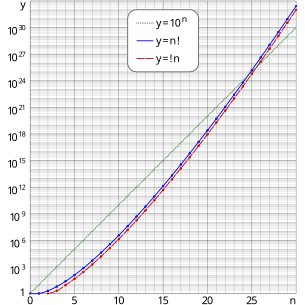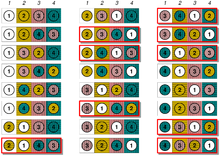Derangement

| Table of values | |||
|---|---|---|---|
| Permutations, | Derangements, | ||
| 0 | 1=1×100 | 1=1×100 | = 1 |
| 1 | 1=1×100 | 0 | = 0 |
| 2 | 2=2×100 | 1=1×100 | = 0.5 |
| 3 | 6=6×100 | 2=2×100 | ≈0.33333 33333 |
| 4 | 24=2.4×101 | 9=9×100 | = 0.375 |
| 5 | 120=1.20×102 | 44=4.4×101 | ≈0.36666 66667 |
| 6 | 720=7.20×102 | 265=2.65×102 | ≈0.36805 55556 |
| 7 | 5,040=5.04×103 | 1,854≈1.85×103 | ≈0.36785,71429 |
| 8 | 40,320≈4.03×104 | 14,833≈1.48×104 | ≈0.36788 19444 |
| 9 | 362,880≈3.63×105 | 133,496≈1.33×105 | ≈0.36787 91887 |
| 10 | 3,628,800≈3.63×106 | 1,334,961≈1.33×106 | ≈0.36787 94643 |
| 11 | 39,916,800≈3.99×107 | 14,684,570≈1.47×107 | ≈0.36787 94392 |
| 12 | 479,001,600≈4.79×108 | 176,214,841≈1.76×108 | ≈0.36787 94413 |
| 13 | 6,227,020,800≈6.23×109 | 2,290,792,932≈2.29×109 | ≈0.36787 94412 |
| 14 | 87,178,291,200≈8.72×1010 | 32,071,101,049≈3.21×1010 | ≈0.36787 94412 |
| 15 | 1,307,674,368,000≈1.31×1012 | 481,066,515,734≈4.81×1011 | ≈0.36787 94412 |
| 16 | 20,922,789,888,000≈2.09×1013 | 7,697,064,251,745≈7.70×1012 | ≈0.36787 94412 |
| 17 | 355,687,428,096,000≈3.56×1014 | 130,850,092,279,664≈1.31×1014 | ≈0.36787 94412 |
| 18 | 6,402,373,705,728,000≈6.40×1015 | 2,355,301,661,033,953≈2.36×1015 | ≈0.36787 94412 |
| 19 | 121,645,100,408,832,000≈1.22×1017 | 44,750,731,559,645,106≈4.48×1016 | ≈0.36787 94412 |
| 20 | 2,432,902,008,176,640,000≈2.43×1018 | 895,014,631,192,902,121≈8.95×1017 | ≈0.36787 94412 |
| 21 | 51,090,942,171,709,440,000≈5.11×1019 | 18,795,307,255,050,944,540≈1.88×1019 | ≈0.36787 94412 |
| 22 | 1,124,000,727,777,607,680,000≈1.12×1021 | 413,496,759,611,120,779,881≈4.13×1020 | ≈0.36787 94412 |
| 23 | 25,852,016,738,884,976,640,000≈2.59×1022 | 9,510,425,471,055,777,937,262≈9.51×1021 | ≈0.36787 94412 |
| 24 | 620,448,401,733,239,439,360,000≈6.20×1023 | 228,250,211,305,338,670,494,289≈2.28×1023 | ≈0.36787 94412 |
| 25 | 15,511,210,043,330,985,984,000,000≈1.55×1025 | 5,706,255,282,633,466,762,357,224≈5.71×1024 | ≈0.36787 94412 |
| 26 | 403,291,461,126,605,635,584,000,000≈4.03×1026 | 148,362,637,348,470,135,821,287,825≈1.48×1026 | ≈0.36787 94412 |
| 27 | 10,888,869,450,418,352,160,768,000,000≈1.09×1028 | 4,005,791,208,408,693,667,174,771,274≈4.01×1027 | ≈0.36787 94412 |
| 28 | 304,888,344,611,713,860,501,504,000,000≈3.05×1029 | 112,162,153,835,443,422,680,893,595,673≈1.12×1029 | ≈0.36787 94412 |
| 29 | 8,841,761,993,739,701,954,543,616,000,000≈8.84×1030 | 3,252,702,461,227,859,257,745,914,274,516≈3.25×1030 | ≈0.36787 94412 |
| 30 | 265,252,859,812,191,058,636,308,480,000,000≈2.65×1032 | 97,581,073,836,835,777,732,377,428,235,481≈9.76×1031 | ≈0.36787 94412 |
Incombinatorialmathematics,aderangementis apermutationof the elements of asetin which no element appears in its original position. In other words, a derangement is a permutation that has nofixed points.
The number of derangements of a set of sizenis known as thesubfactorialofnor then-thderangement numberorn-thde Montmort number(afterPierre Remond de Montmort). Notations for subfactorials in common use include!n,Dn,dn,orn¡.[1][2]
Forn> 0, the subfactorial!nequals the nearest integer ton!/e,wheren!denotes thefactorialofnandeisEuler's number.[3]
The problem of counting derangements was first considered byPierre Raymond de Montmortin hisEssay d'analyse sur les jeux de hazard.[4]in 1708; he solved it in 1713, as didNicholas Bernoulliat about the same time.
Example[edit]

Suppose that a professor gave a test to 4 students – A, B, C, and D – and wants to let them grade each other's tests. Of course, no student should grade their own test. How many ways could the professor hand the tests back to the students for grading, such that no student received their own test back? Out of24 possible permutations(4!) for handing back the tests,
ABCD, ABDC, ACBD, ACDB, ADBC, ADCB, BACD, BADC, BCAD, BCDA, BDAC, BDCA, CABD, CADB, CBAD, CBDA, CDAB, CDBA, DABC, DACB, DBAC, DBCA, DCAB, DCBA.
there are only 9 derangements (shown in blue italics above). In every other permutation of this 4-member set, at least one student gets their own test back (shown in bold red).
Another version of the problem arises when we ask for the number of waysnletters, each addressed to a different person, can be placed innpre-addressed envelopes so that no letter appears in the correctly addressed envelope.
Counting derangements[edit]
Counting derangements of a set amounts to thehat-check problem,in which one considers the number of ways in whichnhats (call themh1throughhn) can be returned tonpeople (P1throughPn) such that no hat makes it back to its owner.[5]
Each person may receive any of then− 1 hats that is not their own. Call the hat which the personP1receiveshiand considerhi's owner:Pireceives eitherP1's hat,h1,or some other. Accordingly, the problem splits into two possible cases:
- Pireceives a hat other thanh1.This case is equivalent to solving the problem withn− 1 people andn− 1 hats because for each of then− 1 people besidesP1there is exactly one hat from among the remainingn− 1 hats that they may not receive (for anyPjbesidesPi,the unreceivable hat ishj,while forPiit ish1). Another way to see this is to renameh1tohi,where the derangement is more explicit: for anyjfrom 2 ton,Pjcannot receivehj.
- Pireceivesh1.In this case the problem reduces ton− 2 people andn− 2 hats, becauseP1receivedhi's hat andPireceivedh1's hat, effectively putting both out of further consideration.
For each of then− 1 hats thatP1may receive, the number of ways thatP2,...,Pnmay all receive hats is the sum of the counts for the two cases.
This gives us the solution to the hat-check problem: stated algebraically, the number!nof derangements of ann-element set is
- for,
whereand.[6]
The number of derangements of small lengths is given in the table below.
| n | 0 | 1 | 2 | 3 | 4 | 5 | 6 | 7 | 8 | 9 | 10 | 11 | 12 | 13 |
|---|---|---|---|---|---|---|---|---|---|---|---|---|---|---|
| !n | 1 | 0 | 1 | 2 | 9 | 44 | 265 | 1,854 | 14,833 | 133,496 | 1,334,961 | 14,684,570 | 176,214,841 | 2,290,792,932 |
There are various other expressions for!n,equivalent to the formula given above. These include
- for
and
- for
whereis thenearest integer functionandis thefloor function.[3][6]
Other related formulas include[3][7] and
The following recurrence also holds:[6]
Derivation by inclusion–exclusion principle[edit]
One may derive a non-recursive formula for the number of derangements of ann-set, as well. Forwe defineto be the set of permutations ofnobjects that fix the-th object. Any intersection of a collection ofiof these sets fixes a particular set ofiobjects and therefore containspermutations. There aresuch collections, so theinclusion–exclusion principleyields and since a derangement is a permutation that leaves none of thenobjects fixed, this implies
On the other hand,since we can choose n - i elements to be in their own place and derange the other i elements in just!i ways, by definition.[8]
Growth of number of derangements asnapproaches ∞[edit]
From and by substitutingone immediately obtains that This is the limit of theprobabilitythat a randomly selected permutation of a large number of objects is a derangement. The probability converges to this limit extremely quickly asnincreases, which is why!nis the nearest integer ton!/e.The abovesemi-loggraph shows that the derangement graph lags the permutation graph by an almost constant value.
More information about this calculation and the above limit may be found in the article on the statistics of random permutations.
Asymptotic expansion in terms of Bell numbers[edit]
An asymptotic expansion for the number ofderangementsin terms ofBell numbersis as follows: whereis any fixed positive integer, anddenotes the-thBell number.Moreover, the constant implied by thebig O-term does not exceed.[9]
Generalizations[edit]
Theproblème des rencontresasks how many permutations of a size-nset have exactlykfixed points.
Derangements are an example of the wider field of constrained permutations. For example, theménage problemasks ifnopposite-sex couples are seated man-woman-man-woman-... around a table, how many ways can they be seated so that nobody is seated next to his or her partner?
More formally, given setsAandS,and some setsUandVofsurjectionsA→S,we often wish to know the number of pairs of functions (f,g) such thatfis inUandgis inV,and for allainA,f(a) ≠g(a); in other words, where for eachfandg,there exists a derangement φ ofSsuch thatf(a) = φ(g(a)).
Another generalization is the following problem:
- How many anagrams with no fixed letters of a given word are there?
For instance, for a word made of only two different letters, saynletters A andmletters B, the answer is, of course, 1 or 0 according to whethern=mor not, for the only way to form an anagram without fixed letters is to exchange all theAwithB,which is possible if and only ifn=m.In the general case, for a word withn1lettersX1,n2lettersX2,...,nrlettersXr,it turns out (after a proper use of theinclusion-exclusionformula) that the answer has the form for a certain sequence of polynomialsPn,wherePnhas degreen.But the above answer for the caser= 2 gives an orthogonality relation, whence thePn's are theLaguerre polynomials(up toa sign that is easily decided).[10]

In particular, for the classical derangements, one has that whereis theupper incomplete gamma function.
Computational complexity[edit]
It isNP-completeto determine whether a givenpermutation group(described by a given set of permutations that generate it) contains any derangements.[11]
References[edit]
- ^The name "subfactorial" originates withWilliam Allen Whitworth;seeCajori, Florian(2011),A History of Mathematical Notations: Two Volumes in One,Cosimo, Inc., p. 77,ISBN9781616405717.
- ^Ronald L. Graham, Donald E. Knuth, Oren Patashnik,Concrete Mathematics(1994), Addison–Wesley, Reading MA.ISBN0-201-55802-5
- ^abcHassani, Mehdi (2003)."Derangements and Applications".Journal of Integer Sequences.6(1): Article 03.1.2.Bibcode:2003JIntS...6...12H.
- ^de Montmort, P. R. (1708).Essay d'analyse sur les jeux de hazard.Paris: Jacque Quillau.Seconde Edition, Revue & augmentée de plusieurs Lettres.Paris: Jacque Quillau. 1713.
- ^Scoville, Richard (1966). "The Hat-Check Problem".American Mathematical Monthly.73(3): 262–265.doi:10.2307/2315337.JSTOR2315337.
- ^abcStanley, Richard(2012).Enumerative Combinatorics, volume 1(2 ed.). Cambridge University Press. Example 2.2.1.ISBN978-1-107-60262-5.
- ^Weisstein, Eric W."Subfactorial".MathWorld.
- ^M. T. L. Bizley, A Note on derangements, Math. Gaz., 51 (May 1967) pp. 118-120.
- ^Hassani, M. "Derangements and Alternating Sum of Permutations by Integration." J. Integer Seq. 23, Article 20.7.8, 1–9, 2020
- ^Even, S.; J. Gillis (1976)."Derangements and Laguerre polynomials".Mathematical Proceedings of the Cambridge Philosophical Society.79(1): 135–143.Bibcode:1976MPCPS..79..135E.doi:10.1017/S0305004100052154.S2CID122311800.Retrieved27 December2011.
- ^Lubiw, Anna(1981), "Some NP-complete problems similar to graph isomorphism",SIAM Journal on Computing,10(1): 11–21,doi:10.1137/0210002,MR0605600.Babai, László(1995), "Automorphism groups, isomorphism, reconstruction",Handbook of combinatorics, Vol. 1, 2(PDF),Amsterdam: Elsevier, pp. 1447–1540,MR1373683,
A surprising result of Anna Lubiw asserts that the following problem is NP-complete: Does a given permutation group have a fixed-point-free element?
.
External links[edit]
- Baez, John(2003)."Let's get deranged!"(PDF).
- Bogart, Kenneth P.; Doyle, Peter G. (1985)."Non-sexist solution of the ménage problem".
- Weisstein, Eric W."Derangement".MathWorld–A Wolfram Web Resource.











![{\displaystyle !n=\left[{\frac {n!}{e}}\right]=\left\lfloor {\frac {n!}{e}}+{\frac {1}{2}}\right\rfloor }](https://wikimedia.org/api/rest_v1/media/math/render/svg/d522701b28d640964b2e50f781b9e10c385898f5)

![{\displaystyle \left[x\right]}](https://wikimedia.org/api/rest_v1/media/math/render/svg/bee30b48da3d61e9dfa898ca4d209afdcc6503dc)























